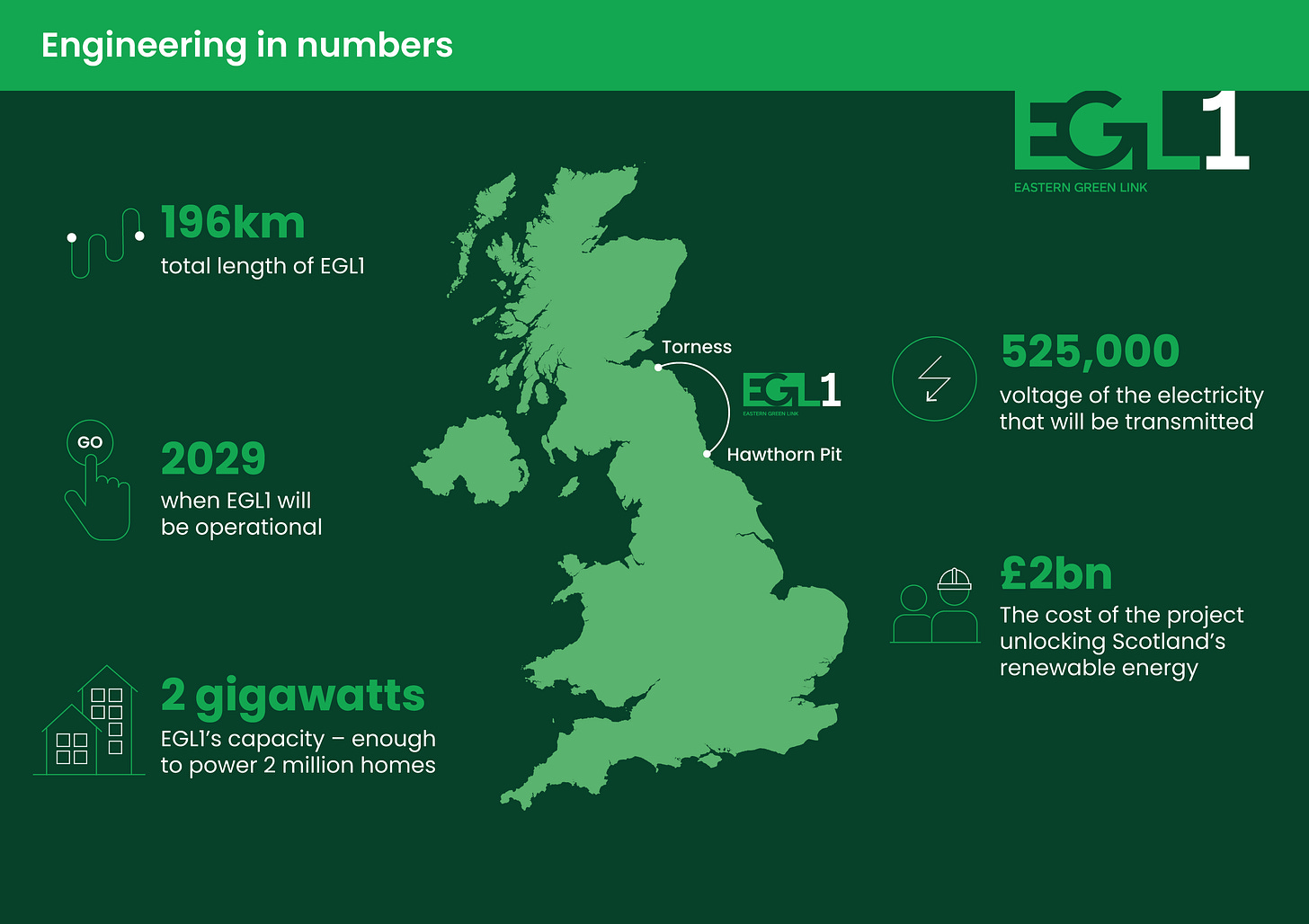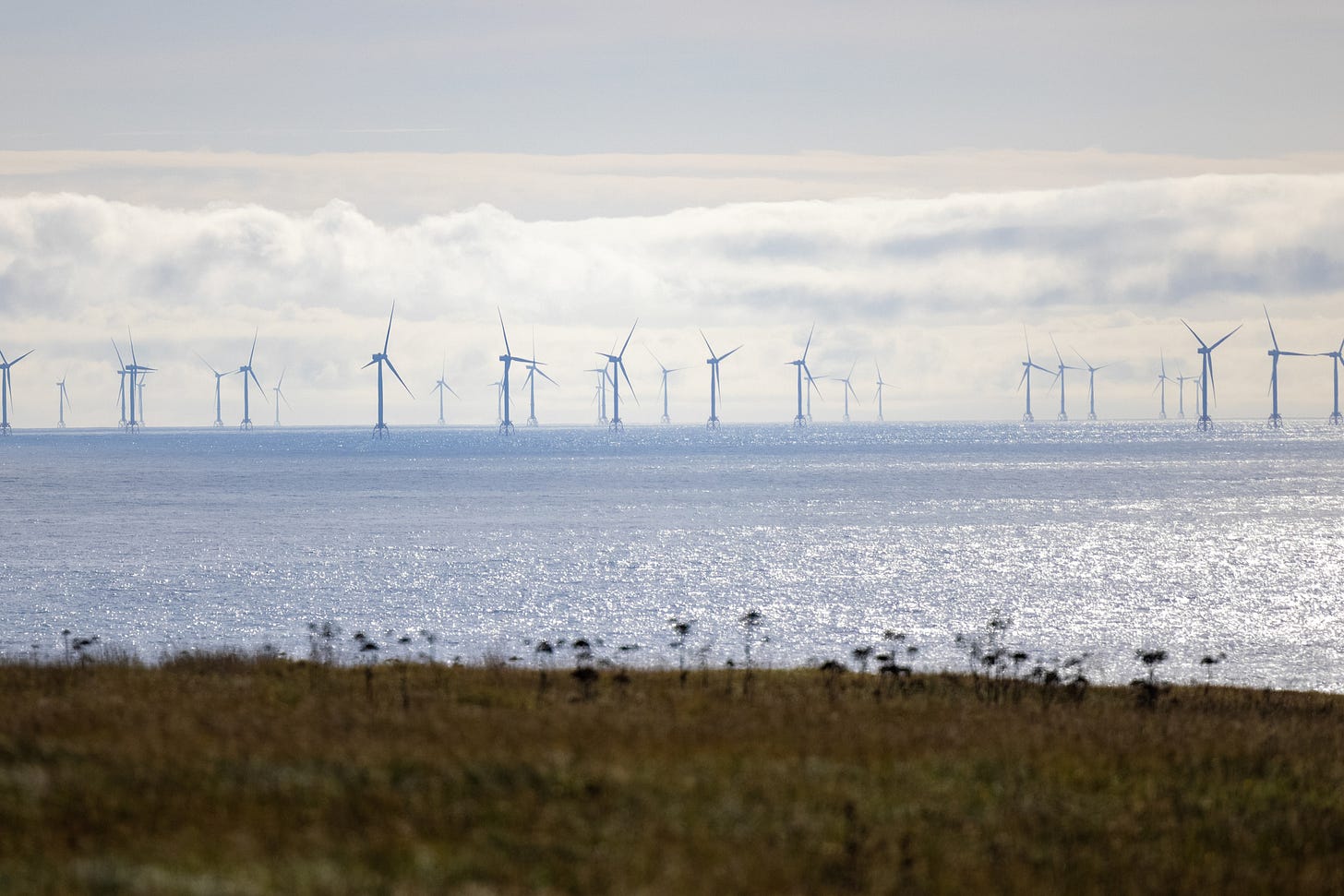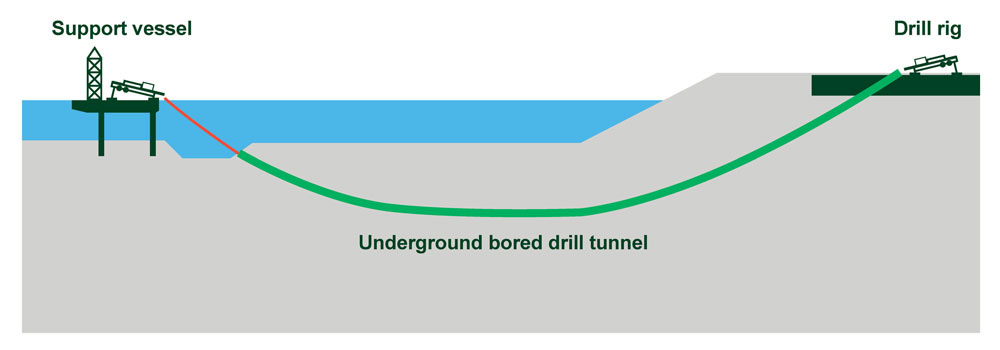Britain's electric undersea highway
How do you transfer 2GW of green electricity across the North Sea?
Welcome to another edition of The Off Site, brought to you by Aphex.
Scotland generates more renewable electricity than it can use. England needs more clean power. Both countries need more resilient energy grids. The solution is simple enough: run a cable between them.
England, Scotland, and Wales have already planned and executed several of these links, but the Eastern Green Link 1 (EGL1) is the most ambitious. The £2.5 billion project will transport 2GW of Scottish wind power through 196 kilometres of cable — mostly underwater — from Torness in Scotland’s East Lothian to Hawthorn Pit in County Durham.
It's part of Britain's "Great Grid Upgrade," a multibillion-pound effort to modernise the electricity network for an ongoing clean energy transition. But, naturally, building a subsea power highway across the North Sea comes with a raft of engineering challenges.
Why build an electricity superhighway?
Scotland's renewable energy output is impressive but geographically awkward. The country generated 113% of its electricity consumption from renewables in 2022, and had to ask wind farms to curtail production due to a lack of transmission capacity to move the power south.
According to the National Energy System Operator, EGL1 will deliver annual savings of over £870 million by reducing compensation payments to wind generators.
The project forms part of the government's Clean Power 2030 ambition. As Energy Minister Michael Shanks explains, EGL1 is “part of our once-in-a-generation upgrade to Britain's energy infrastructure, using some of the most advanced subsea technology in the world."
EGL1 is the first of four planned England-Scotland HVDC interconnectors. The £4.3 billion EGL2 between Peterhead and Drax will follow, using 436km of undersea cable to become the UK's longest HVDC connection.
Converting and transmitting power
The first necessary piece of infrastructure handles electricity conversion. Scotland's existing network runs on high-voltage alternating current (HVAC), but long-distance transmission requires high-voltage direct current (HVDC) for efficiency.
Two converter stations will handle this transformation. 7-hectare sites at Torness and Hawthorn Pit will house conversion stations to convert electricity between AC and DC using ±525 kV HVDC technology.
The subsea cable consists of two electrical cables and a fibre optic cable. Nearly 400km of power cable is required for the 196km route — the additional length accounts for the cable's installation pattern on the seabed and redundancy requirements.
Navigating North Sea geology
The 176km subsea section presents complex engineering challenges, and the North Sea's variable geology demands different installation approaches across the route.
Pre-installation surveys identified over 1,300 boulders near the Scottish landfall, requiring boulder clearance trials before cable laying can begin.
For the geology nerds, the cable route goes through Holocene-era silty sand and sandy clay substrates. On top of this, the seabed is dynamic, and difficult to bury cables in — large sandwaves, and megaripples up to 2.5 metres high are formed by strong North Sea currents.
As a result, burial methods will be tailored to the relevant seabed conditions:
In sand-dominated areas, water-jetting trenchers will fluidise sediments with high-pressure water, before burying cables about a metre deep;
In hard or rocky areas where burial isn't feasible, mechanical trenchers or concrete mattresses will be employed.
Horizontal directional drilling
The project uses horizontal directional drilling (HDD) at both landfalls to install ducts under intertidal zones and seabeds close to shore. It’s a trenchless method that both minimises the environmental impact on sensitive coastal habitats and provides a secure cable route.
With this technique, conduits are drilled in a shallow arc along a prescribed path, which allows cables to be pulled through without disturbing the surface. For EGL1, this will help avoid direct excavation in ecologically sensitive areas while ensuring a secure connection.
Then, the 20km of onshore cabling — 10km in each country — will be buried 0.6-1.5 metres deep in underground ducts. Once installation is complete, the Scottish and English joint venture has promised to restore the land above to its previous coastal grassland.
Who's building what
EGL1 is a joint venture between SP Energy Networks (transmission operator for Central and South Scotland, North England, and North Wales) and National Grid Electricity Transmission (England and Wales).
Major contracts worth around £1.8 billion have been awarded:
Prysmian Group secured a £750 million contract to supply nearly 400km of power cable.
A consortium of GE Vernova and MYTILINEOS received a £1 billion contract to supply and construct the two HVDC converter stations.
Murphy handles initial onshore construction work, with offshore operations planned for summer 2025.
Britain's energy regulator, Ofgem (Office of Gas and Electricity Markets), granted the project approval and fast-tracked funding through its new Accelerated Strategic Transmission Investment framework.
Costs and timeline
The project's budget has grown from an initial request of £1.65 billion for direct construction to £2.5 billion. Ofgem cited demand and commodity inflation driving cost increases across all electricity transmission projects.
The budget includes £7.9 million for a social value and community benefit fund to ensure hosting communities benefit from the infrastructure, plus another £7.9 million for a carbon innovation fund supporting UK net zero targets.
Construction began in March 2025 with onshore works. Offshore cable laying is scheduled for summer 2025, with full operation targeted for 2029 — two years later than initially promised during consultation.
Part of a bigger picture
EGL1 follows in the wake of the Western Link, which connects Hunterston in Scotland to Connah's Quay in Wales. That 240-mile cable has been operational since 2017, transmitting more than 23,000 GWh of green energy in its first five years.
The broader Green Link programme includes plans for connections between Peterhead and Lincolnshire, then between Kinghorn in Fife and Norfolk. Combined with planned upgrades of powerlines across Scotland, these projects aim to deliver the UK government's target of 50GW of offshore wind power by 2030.
SSEN Transmission suggests the wider programme could see investment exceed £24 billion this decade, directly addressing the UK's energy security challenges and reducing reliance on international gas markets.
For now, EGL1 tests whether Britain can successfully build the transmission infrastructure needed for its clean energy ambitions. The technical challenges are significant but manageable. Whether the project stays on schedule and budget will indicate how smoothly the broader grid upgrade programme might proceed.





